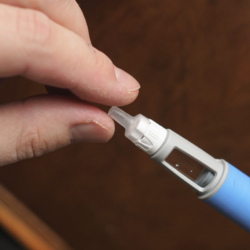Anaemia is a common blood disorder, most often the result of iron deficiency. It therefore represents a real public health issue, affecting more than one and a half billion people worldwide. The people most at risk are children, adolescents, pregnant women and women of childbearing age. However, the condition affects all age groups, including men and the elderly.
In France, it is estimated that 25% of women before the menopause have an iron deficiency, with 5% suffering from proven anaemia. In men and the elderly, anaemia is less common, but remains a source of concern because of its possible repercussions on general health.
What is anaemia and how do you recognise it?
Anemia is defined as a drop in the level of haemoglobin in the blood. This protein, contained in red blood cells, is essential for transporting oxygen to the cells. When haemoglobin levels fall, the body receives less oxygen, leading to intense fatigue, a pale complexion, shortness of breath on exertion and sometimes dizziness or headaches.
It is not a single disease, but a syndrome that may have several underlying causes. Anemia may be mild and go unnoticed, or it may manifest itself with obvious clinical signs that impair quality of life.
What are the biological mechanisms behind anaemia?
Three main mechanisms can cause anaemia:
- Acute or chronic blood loss, such as heavy periods or digestive haemorrhage.
- A reduction in the production of red blood cells by the bone marrow, often linked to nutritional deficiencies or chronic illnesses.
- An increase in the destruction of red blood cells, a phenomenon known as haemolysis, which may be immunological, infectious or genetic in origin.
Understanding these mechanisms makes it possible to identify the type of anaemia in question and to propose an appropriate treatment, whether medical or natural.
What are the different types of anaemia and how can they be distinguished?
Anemia does not manifest itself in the same way in all patients. There are several categories, depending on the size of the red blood cells (mean blood cell volume), their haemoglobin level and the capacity of the bone marrow to produce new blood cells (reticulocyte level).
Aregenerative hypochromic microcytic anaemia
This is the most common form. The red blood cells are small and poorly coloured due to a lack of haemoglobin. This type of anaemia is generally due to iron deficiency, linked to inadequate intake or excessive losses (heavy periods, digestive bleeding).
Aregenerative macrocytic normochromic anaemia
Here, the red blood cells are larger than normal. This anaemia is often linked to a vitamin B12 or folic acid (vitamin B9) deficiency. It may be of nutritional origin or result from a disorder of intestinal absorption. Biermer anaemia, for example, is an autoimmune form of vitamin B12 deficiency.
Normocytic normochromic regenerative anaemia
In this case, the red blood cells are of normal size, but their destruction is accelerated. This is known as haemolytic anaemia, and is caused by infections, certain genetic diseases such as sickle cell anaemia, or reactions to certain drugs.
Aregenerative normocytic normochromic anaemia
This rarer form results from bone marrow dysfunction. Pathologies such as leukaemia, certain genetic diseases (thalassaemia), or hormonal deficiencies (hypothyroidism, renal failure) can cause this anaemia.
What are the clinical signs of anaemia?
Symptoms vary depending on the severity of the anaemia and its cause. However, several signs are common to all forms:
- Persistent fatigue, even after resting
- Pale complexion and mucous membranes
- Palpitations and shortness of breath on exertion
- Feeling of dizziness, headaches
- Decreased concentration, memory problems
- In some patients, reduced libido or mood disorders
When anaemia is linked to an iron deficiency, other signs may appear: brittle nails, dry hair, dry skin, or even cracks at the corners of the lips.
Forms linked to a vitamin B12 deficiency may be accompanied by neurological symptoms: tingling in the limbs, numbness, balance problems.
Signs of haemolytic anaemia include yellow eyes (subicterus), dark urine and an enlarged spleen.
Who is most at risk of anaemia?
Women of childbearing age, especially those on IUDs, are particularly at risk because of their heavy periods. Pregnant or breast-feeding women, as well as growing adolescents, can also be at risk of iron deficiency if their diet is not sufficiently balanced.
In children living in precarious conditions, certain types of poisoning (lead, old paintwork, drains) can disrupt the production of red blood cells.
Anemia due to digestive losses (ulcers, polyps, irritant medicines) often affects the elderly, but can also be caused by dietary deficiencies, sometimes linked to a reduced appetite or digestive problems.
What are the medical causes of anaemia?
In addition to blood loss and nutritional deficiencies, other conditions can cause anaemia:
- Chronic inflammation (polyarthritis, lupus, tuberculosis, HIV)
- Cancers affecting the marrow or causing occult bleeding
- Kidney diseases that interfere with the production of erythropoietin, the hormone that stimulates bone marrow
- Genetic diseases (sickle cell anaemia, thalassaemia, spherocytosis)
- Exposure to toxic substances or certain drugs
It is essential to consult a healthcare professional to determine the exact cause of the anaemia, as treatment depends closely on the diagnosis.
What are the possible complications of anaemia?
If left untreated, anaemia can have serious health consequences. Severe chronic anaemia can overwork the heart and lead to angina pectoris, or even increase the risk of heart attack in frail people.
Prolonged vitamin B12 deficiency can cause irreversible neurological damage if not corrected in time.
Finally, some haemolytic anaemias can lead to serious kidney damage, requiring urgent treatment.
Anemia is a complex disorder with multiple causes, and deserves special attention from the very first signs. Although the most common forms are linked to iron or vitamin deficiencies, other more serious causes may be involved. A medical consultation is essential to establish a precise diagnosis and implement appropriate treatment.





